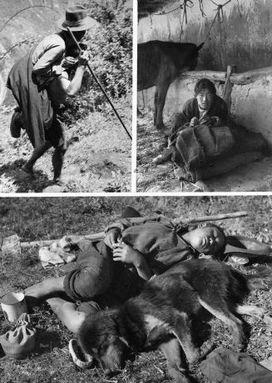The beautiful and distant Tibet we see today, the blue lake, the scene of the unity of heaven and man, the scene of the herd of cattle, let countless people fall for it, but this was not the case before the 1959 Tibet Reform Year, because at that time 95% of the people in Tibet were serfs, and without today's sunshine, some were only the blood and tears of serfs.

Tibetan serfs
Serfdom in Tibet has also undergone a long period of change, in tibet during the Tubo Dynasty, Tibet is still the most primitive slave system, because the slave system is too brutal, exterminate people, slaves began to revolt continuously, the tubo dynasty at the end of the slaves continued to carry out 8 years of uprising, after the overthrow of the Tubo dynasty Tibet entered a nearly 400-year division, until the arrival of the Mongols to end all this.
During these 400 years, the big slave owners slowly began to change their minds, and decided to turn slaves into serfs in order to ensure that their interests could be enjoyed continuously. From the founding of the Yellow Sect by Tsongkhapa to the seizure of local power in Tibet by the Fifth Dalai Lama, the Fourth Panchen Lama and Gushi Khan, it can be said that it was a period of rise in Tibetan serfdom, when serfdom gradually spread to the entire region of Tibet, and when the Fifth Dalai Lama and Gushi Khan seized local power in Tibet, it was the period of the rise of Tibetan serfdom and reached its peak, when The Tibetan serfdom formally formed three major lords, namely monastic lords, government lords and aristocratic lords.
Foot cuffs that accompany a lifetime
In ancient agricultural societies, the main source of income for people was land, and the serfdom system in Tibet stipulated that the land in Tibet could only be owned by monastic monks, government lords and aristocratic lords, so they controlled all the wealth of Tibet.
In order to make this right permanent, the three lords would give the serfs some land so that they would have a hope so that they would not revolt again. However, in this little bit of land, the lords would levy a large amount of taxes, a land tax on farming, a sheep's head tax for sheep herders, and even if the serfs did nothing, they had to pay taxes, that is, the poll tax, and anyway, as long as they could breathe, they had to pay taxes. Taxes accounted for about 70 percent of the total income of serfs, which was too heavy, but they could barely make ends meet. But this is not the end, in addition to this there is heavy servitude, to the serf owners to serve the servitude, but also to the government to serve the servitude, a year of about 200 days.
Since there was a certain means of production and relative freedom, there would then be a stratification within the serfs, which could be roughly divided into rich serfs, middle serfs and poor serfs.
Because of old age, abandoned serfs
Poor serfs are the lowest level of serfs, and they will often not be able to pay taxes, but it doesn't matter, the serf owners will think of ways for you, that is, usury, not only the serf owners, the monasteries and the government are not willing to give up this violent business, until the poor serfs go bankrupt, when they have neither the means of production nor the freedom of life, they will be completely occupied by the serf owners, used for domestic labor, become slaves, this kind of person is the most miserable similar to the ancient Indian untouchables, at the end of society, they carry anklets every day, to the serf owners as cattle and horses, But the status is far inferior to that of livestock, after all, livestock still have a place to live, and they can only sleep on the ground, and the serf owners may be reluctant to beat the livestock, but they can kill them.
Torture instruments against serfs
In order for these serfs to work hard and do a good job, the Tibetan localities also formulated rather harsh punishments, ranging from whipping at will to severed hands and feet and even gouging out their eyes. If necessary, the serf owners would also peel the skin of the serfs and make adult pittonkas and human skin drums to show their status. For the serfs, the only thing that may belong to them in this life is a shadow.
Today's bustling streets of Lhasa are no longer blood and tears, but more of people's love for life.